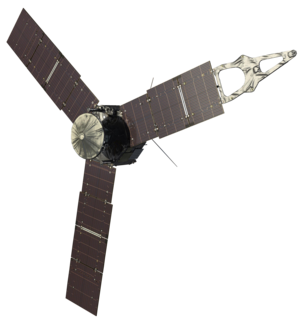
Back Juno (ruimtetuig) Afrikaans Juno (sonda espacial) AN جونو (مسبار فضائي) Arabic Juno BCL Юнона (касмічны апарат) Byelorussian Juno (svemirska letjelica) BS Juno (sonda) Catalan کەشتیی ئاسمانیی جونۆ CKB Juno (sonda) Czech Juno (chwiliedydd) Welsh
 Artist's rendering of the Juno spacecraft | |
| Names | New Frontiers 2 |
|---|---|
| Mission type | Jupiter orbiter |
| Operator | NASA / Jet Propulsion Laboratory |
| COSPAR ID | 2011-040A |
| SATCAT no. | 37773 |
| Website | |
| Mission duration | Planned: 7 years Elapsed: 13 years, 5 months, 21 days Cruise: 4 years, 10 months, 29 days Science phase: 3 years, 5 months and 27 days (in progress; extended until September 2025) |
| Spacecraft properties | |
| Manufacturer | Lockheed Martin Space |
| Launch mass | 3,625 kg (7,992 lb) [1] |
| Dry mass | 1,593 kg (3,512 lb) [2] |
| Dimensions | 20.1 × 4.6 m (66 × 15 ft) [2] |
| Power | 14 kW at Earth,[2] 435 W at Jupiter [1] 2 × 55-ampere hour lithium-ion batteries[2] |
| Start of mission | |
| Launch date | August 5, 2011, 16:25:00 UTC |
| Rocket | Atlas V 551 (AV-029) |
| Launch site | Cape Canaveral, SLC-41 |
| Contractor | United Launch Alliance |
| Flyby of Earth | |
| Closest approach | October 9, 2013 |
| Distance | 559 km (347 mi) |
| Jupiter orbiter | |
| Orbital insertion | July 5, 2016,[3] 8 years, 6 months, 21 days ago |
| Orbits | 76 (planned) [4][5] |
| Orbital parameters | |
| Perijove altitude | 4,200 km (2,600 mi) altitude 75,600 km (47,000 mi) radius |
| Apojove altitude | 8.1×106 km (5.0×106 mi) |
| Inclination | 90° (polar orbit) |
 Juno mission patch | |

Juno is a NASA space probe orbiting the planet Jupiter. It was built by Lockheed Martin and is operated by NASA's Jet Propulsion Laboratory. The spacecraft was launched from Cape Canaveral Air Force Station on August 5, 2011 UTC, as part of the New Frontiers program.[6] Juno entered a polar orbit of Jupiter on July 5, 2016, UTC,[4][7] to begin a scientific investigation of the planet.[8] After completing its mission, Juno was originally planned to be intentionally deorbited into Jupiter's atmosphere,[8] but has since been approved to continue orbiting until contact is lost with the spacecraft.
Juno's mission is to measure Jupiter's composition, gravitational field, magnetic field, and polar magnetosphere. It will also search for clues about how the planet formed, including whether it has a rocky core, the amount of water present within the deep atmosphere, mass distribution, and its deep winds, which can reach speeds up to 620 km/h (390 mph).[9]
Juno is the second spacecraft to orbit Jupiter, after the nuclear powered Galileo orbiter, which orbited from 1995 to 2003.[8] Unlike all earlier spacecraft sent to the outer planets,[8] Juno is powered by solar panels, commonly used by satellites orbiting Earth and working in the inner Solar System, whereas radioisotope thermoelectric generators are commonly used for missions to the outer Solar System and beyond. For Juno, however, the three largest solar panel wings ever deployed on a planetary probe (at the time of launching) play an integral role in stabilizing the spacecraft as well as generating power.[10]
- ^ a b "Juno Mission to Jupiter" (PDF). NASA FACTS. NASA. April 2009. p. 1. Archived (PDF) from the original on April 6, 2020. Retrieved April 5, 2011.
 This article incorporates text from this source, which is in the public domain.
This article incorporates text from this source, which is in the public domain.
- ^ a b c d "Jupiter Orbit Insertion Press Kit" (PDF). NASA. 2016. Archived (PDF) from the original on August 14, 2016. Retrieved July 7, 2016.
 This article incorporates text from this source, which is in the public domain.
This article incorporates text from this source, which is in the public domain.
- ^ Foust, Jeff (July 5, 2016). "Juno enters orbit around Jupiter". SpaceNews. Archived from the original on December 31, 2016. Retrieved August 25, 2016.
- ^ a b Chang, Kenneth (July 5, 2016). "NASA's Juno Spacecraft Enters Jupiter's Orbit". The New York Times. Archived from the original on May 2, 2019. Retrieved July 5, 2016.
- ^ Greicius, Tony (September 21, 2015). "Juno – Mission Overview". NASA. Archived from the original on September 7, 2018. Retrieved October 2, 2015.
 This article incorporates text from this source, which is in the public domain.
This article incorporates text from this source, which is in the public domain.
- ^ Dunn, Marcia (August 5, 2011). "NASA probe blasts off for Jupiter after launch-pad snags". NBC News. Archived from the original on September 14, 2019. Retrieved August 31, 2011.
- ^ Chang, Kenneth (June 28, 2016). "NASA's Juno Spacecraft Will Soon Be in Jupiter's Grip". The New York Times. Archived from the original on August 14, 2018. Retrieved June 30, 2016.
- ^ a b c d Riskin, Dan (July 4, 2016). Mission Jupiter (Television documentary). Science Channel.
- ^ Cheng, Andrew; Buckley, Mike; Steigerwald, Bill (May 21, 2008). "Winds in Jupiter's Little Red Spot Almost Twice as Fast as Strongest Hurricane". NASA. Archived from the original on May 13, 2017. Retrieved August 9, 2017.
 This article incorporates text from this source, which is in the public domain.
This article incorporates text from this source, which is in the public domain.
- ^ "Juno's Solar Cells Ready to Light Up Jupiter Mission". NASA. July 15, 2011. Archived from the original on February 16, 2017. Retrieved October 4, 2015.
 This article incorporates text from this source, which is in the public domain.
This article incorporates text from this source, which is in the public domain.